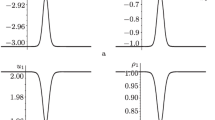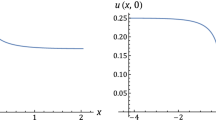Abstract
We construct and study Darboux transformations for the \((2{+}1)\)-dimensional Camassa–Holm system. We apply a reciprocal transformation that relates the \((2{+}1)\)-dimensional Camassa–Holm system and the linear system associated with the modified Kadomtsev–Petviashvili hierarchy. Using three Darboux transformation operators, we obtain three types of solutions for the \((2{+}1)\)-dimensional Camassa–Holm system, of which one is a multisoliton solution. In addition, we briefly discuss rational solutions.






Similar content being viewed by others
References
R. A. Kraenkel and A. I. Zenchuk, “Two-dimensional integrable generalization of the Camassa–Holm equation,” Phys. Lett. A, 260, 218–224 (1999).
R. A. Kraenkel, M. Senthilvelan, and A. I. Zenchuk, “Lie symmetry analysis and reductions of a two-dimensional integrable generalization of the Camassa–Holm equation,” Phys. Lett. A, 273, 183–193 (2000).
P. R. Gordoa, A. Pickering, and M. Senthilvelan, “A note on the Painlevé analysis of a (2+1) dimensional Camassa–Holm equation,” Chaos Solitons Fractals, 28, 1281–1284 (2006).
A. I. Zenchuk, “The spectral problem and particular solutions to the (2+1)-dimensional integrable generalization of the Camassa–Holm equation,” Phys. D, 152–153, 178–188 (2001).
N. Lv, J.-Q. Mei, and H.-Q. Zhang, “Differential form method for finding symmetries of a (2+1)-dimensional Camassa–Holm system based on its Lax pair,” Chaos Soliton Fractals, 45, 503–506 (2012).
R. Camassa and D. D. Holm, “An integrable shallow water equation with peaked solitons,” Phys. Rev. Lett., 71, 1661–1664 (1993); arXiv:patt-sol/9305002v1 (1993).
B. Fuchssteiner and A. S. Fokas, “Symplectic structures, their Bäcklund transformation, and hereditary symmetries,” Phys. D, 4, 47–66 (1981).
V. B. Matveev and M. A. Salle, Darboux Transformations and Solitons, Springer, Berlin (1991).
L.-L. Chau, J.-C. Shaw, and M.-H. Tu, “Solving the constrained KP hierarchy by gauge transformations,” J. Math. Phys., 38, 4128–4137 (1997).
W. Oevel and C. Rogers, “Gauge transformations and reciprocal links in 2+1 dimensions,” Rev. Math. Phys, 5, 299–330 (1993).
W. Oevel, “Darboux theorems and Wronskian formulas for integrable system I: Constrained KP flows,” Phys. A, 195, 533–576 (1993).
J.-C. Shaw and M.-H. Tu, “Miura and auto-Bäcklund transformations for the cKP and cmKP hierarchies,” J. Math. Phys., 38, 5756–5773 (1997).
J. C. Shaw and H. C. Yen, “Miura and Bäcklund transformations for hierarchies of integrable equations,” Chin. J. Phys., 31, 709–719 (1993).
R. Willox, I. Loris, and C. R. Gilson, “Binary Darboux transformations for constrained KP hierarchies,” Inverse Problems, 13, 849–865 (1997).
J. Cheng, “The gauge transformation of the modifified KP hierarchy,” J. Nonlinear Math. Phys., 25, 66–85 (2018).
Y. Li and J. E. Zhang, “The multiple-soliton solution of the Camassa–Holm equation,” Proc. R. Soc. London Ser. A, 460, 2617–2627 (2004).
B. Xia, R. Zhou, and Z. Qiao, “Darboux transformation and multi-soliton solutions of the Camassa–Holm equation and modified Camassa–Holm equation,” J. Math. Phys., 57, 103502 (2016); arXiv:1506.08639v2 [nlin.SI] (2015).
B. Konopelchenko, Solitons in Multidimensions: Inverse Spectral Transform Method, Singapore, World Scientific (1993).
Funding
This research is supported by the National Natural Science Foundation of China (Grant Nos. 11905110 and 11871471), the Natural Science Foundation of Guangxi Zhuang Autonomous Region, China (Grant No. 2018GXNSFBA050020), and the Promotion Program for Young and Middle-aged Teacher in Science and Technology Research of Guangxi Zhuang Autonomous Region, China (Grant No. 2019KY0417).
Author information
Authors and Affiliations
Corresponding author
Ethics declarations
The author declares no conflicts of interest.
Rights and permissions
About this article
Cite this article
Mao, H. Obtaining multisoliton solutions of the (2+1)-dimensional Camassa–Holm system using Darboux transformations. Theor Math Phys 205, 1638–1651 (2020). https://doi.org/10.1134/S0040577920120065
Received:
Revised:
Accepted:
Published:
Issue Date:
DOI: https://doi.org/10.1134/S0040577920120065




